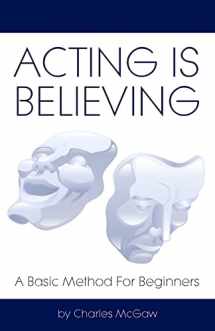
Acting Is Believing: A Basic Method For Beginners
Book details
Summary
Description
Although the materials in this book are organized in such a way as to make them practical for classroom use, they are intended for any reader who is interested in a basic approach to the art of acting; and though the book has been written with the stage actor in mind, the methods described may be used as well by the actor in any other field. The basic approach to acting is the same for the proscenium stage, theatre-in-the-round, motion pictures, television, and radio. The differences lie in the differing technical adjustments required by these various mediums. The approach here presented is based, to a considerable extent, on the methods of Stanislavski. The borrowings have been recognized throughout, and the debt to Stanislavski and to certain of his followers is gratefully acknowledged. In no sense, however, does the book pretend to be an interpretation of the Stanislavski “system.” It attempts only to draw upon some aspects of the system which have proved to be practical in helping beginning actors to develop an effective technique for bringing a character into existence on the stage. In some instances the vocabulary of Stanislavski's translators has been employed. Other terms have been used wherever they seemed to have greater clarity. Stanislavski's influence has been admittedly great, but the extent of that influence on the modern theatre is difficult to determine. It would seem that his principal contribution consists, not in his having originated a “system,” but rather in his detailed analysis and careful setting down of the attitudes and techniques which have been used more or less consciously by fine actors in all periods of theatrical history. Such knowledge as one can obtain of the working methods of great actors of the past indicates that they have always made imaginative use of their own experiences and that they have always striven for truth and a sense of reality in their performances. Furthermore, a study of all of the writings of Stanislavski gives ample evidence of his awareness that an actor's characterization must be theatrically effective as well as truthfully conceived. This book is based upon the following assumptions: 1), Although genius in acting may be a quality that defies analysis, the art as it is generally practiced consists of certain basic skills that may be mastered to some degree by anyone who sincerely wants to do so. 2) Mastery of those skills is much harder and more demanding work than most would-be actors realize. 3) The aspiring actor must recognize that, although rehearsals and performances before an audience are vitally important to his growth, he must also develop his skills through individual practice and effort. Only in this way can he succeed in his aim of becoming a creative artist. Part I, The Actor and Himself, is intended to help the young actor to develop himself individually. Part II, The Actor and the Play, is intended to help the actor to use his individual creative skills to express the meaning of the play as it has been conceived by the dramatist. Part III, The Actor and the Production, is designed to help the actor in his relations with the director and to aid him in making the necessary adjustments to the technical elements of a theatrical production. The exercises throughout have been taken directly from modern and classic plays so that the actor may always understand the applicability of the theory he is attempting to put into practice.


We would LOVE it if you could help us and other readers by reviewing the book
Book review



